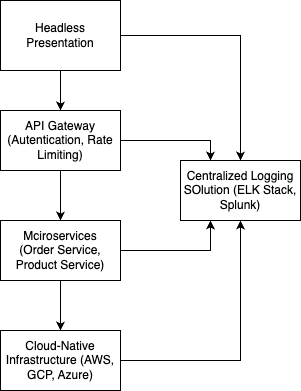Security Considerations for MACH Architectures
Securing the Future: Navigating MACH Architectures with Confidence
It is a fiercely competitive and economically challenging business landscape, the relentless pursuit of digital innovation is non-negotiable. Businesses are constantly striving for agility, scalability, and, crucially, rock-solid security to keep pace with relentless change. One architectural paradigm that has truly taken hold is MACH (Microservices, API-First, Cloud-Native, Headless). While I’ve witnessed glimpses of this in enormous organisations wrestling with decades of legacy systems, it was only when I had the privilege of helping a client build an entire banking infrastructure from the ground up in the cloud that I truly grasped MACH’s transformative power – its ability to enable blistering speed and rapid adaptation in the face of fierce competition and emerging technologies.
Moving at pace, however, brings its own set of security challenges. We, as security professionals, must match the business’s ambition stride for stride, knowing that our decisions ultimately dictate success or failure. Our very purpose is to enable and protect the organisation; if we falter, the business will too. This underscores a critical need: architecting security that accelerates the business, rather than hindering it.
To set the scene, let’s quickly unpack what MACH actually means. Microservices refers to the practice of deconstructing sprawling, monolithic applications into smaller, independent services that elegantly communicate with one another via APIs. This leads us to API-First development, which prioritises the design and implementation of these APIs as the primary interface for interacting with your microservices. This approach means you can update and release new versions of an API multiple times throughout the day – small, iterative steps. If something goes awry, a swift rollback is almost instantaneous. Contrast that with traditional monolithic systems, where a new version rollout could take days, weeks, or even months!
Next, we have Cloud-Native architectures, which are purpose-built to harness the full might of cloud computing principles: unparalleled scalability, on-demand resources, and seamless managed services. Finally, Headless denotes the strategic separation of the presentation layer (what users see) from the core business logic, granting immense flexibility in how applications are consumed and interacted with.
As you can see in the following diagram, a MACH architecture is a dynamic ecosystem of microservices communicating via APIs, all powered by a customisable, headless presentation layer tailored to diverse user needs.
If “headless” sounds a bit abstract, imagine being a retailer keen to sell products across numerous channels – perhaps your own website, Amazon, Facebook, and Instagram. You want to offer a truly seamless shopping experience across all these platforms, but juggling different storefronts and inventory systems becomes an immediate headache.
This is precisely where headless e-commerce comes into its own. It deftly separates the frontend (the user interface) from the backend (the commerce functionality). This ingenious division allows you to wield a single commerce engine to manage your products, inventory, and orders, while simultaneously presenting a bespoke shopping experience on each individual platform.

Now, the MACH architecture itself, despite its many benefits, does introduce a unique set of security challenges. For starters, the sheer increase in attack surface – stemming from the proliferation of microservices and APIs – unfortunately offers more avenues for attackers to probe and exploit vulnerabilities. The inherent cloud-native infrastructure also ushers in new risks, where even a simple misconfiguration can lead to devastating data breaches, unauthorised access, and debilitating denial-of-service attacks.
To effectively counteract these risks, we must adopt a risk-driven approach to security architecture, unequivocally prioritising the protection of sensitive data and mission-critical business services. This can be achieved by implementing robust authentication and authorisation mechanisms, such as OAuth 2.0 or OpenID Connect, to meticulously control access to microservices and APIs. Crucially, we must also embed encryption for data both in transit and at rest, leveraging protocols like TLS and AES, all while ensuring cryptographic keys are stored with the utmost care.
Another pivotal aspect of fortifying MACH architectures lies in meticulous monitoring and logging. With so many interconnected moving parts, gaining clear visibility into system activity, performance, and security-related events isn’t just helpful; it’s absolutely vital. This visibility can be realised through the implementation of centralised logging solutions, such as an ELK Stack or Splunk, providing real-time, actionable insights into system behaviour.
Furthermore, we must place a high priority on the security of our APIs, which often serve as the primary conduits for interaction with microservices. My strong recommendation is to implement API gateways that offer features such as rate limiting, IP blocking, and quotas to effectively thwart abuse. We should also proactively employ tools like API security scanners to pinpoint vulnerabilities in our APIs, addressing them thoroughly before they can be exploited. And, of course, a comprehensive independent penetration test prior to going live is always a shrewd investment.
As we continue to evolve our MACH architectures, it’s absolutely essential that we simultaneously embrace sound DevSecOps practices, embedding security right into every stage of the development lifecycle. Developers need to move quickly, and we, in security, must provide automated, trusted tests for code being promoted to production. It truly requires a holistic approach that directly tackles the unique challenges presented by microservices, APIs, cloud-native infrastructure, and headless presentation layers.
What might this look like in practice? Let’s consider a scenario: an e-commerce company embarking on a MACH architecture journey to enhance the scalability and flexibility of its online platform. This company has meticulously broken down its traditional monolithic application into smaller microservices, each singularly responsible for a specific function, such as order management or product cataloguing. To secure these microservices, the company strategically implements an API gateway that provides robust authentication, precise rate limiting, and effective quotas to prevent misuse. The company also wisely employs encryption to safeguard sensitive data both in transit and at rest, and deploys centralised logging solutions to meticulously monitor system activity and performance.
As illustrated in the diagram below, this e-commerce company’s MACH architecture is inherently designed with security woven into its very fabric – from the individual microservices and APIs to the underlying cloud-native infrastructure and the user-facing headless presentation layer:

By steadfastly following this approach, the e-commerce company can confidently ensure the security and integrity of its MACH architecture, diligently protecting sensitive data and critical business services from unauthorised access and malicious activity.
Given that APIs are the primary interface for interacting with microservices, they offer a rich vein of functionality that, if not properly secured, can be dangerously leveraged by attackers. Therefore, it’s crucial to understand the fundamental risks inherent in this architecture:
- Authentication Bypass: Attackers may cunningly attempt to bypass authentication mechanisms to gain unauthorised access to sensitive data or functionality.
- Data Breaches: APIs can be alarmingly vulnerable to data breaches if sensitive information isn’t properly encrypted or if authentication mechanisms are inherently weak.
- Denial-of-Service (DoS) Attacks: APIs can become prime targets for DoS attacks, which can cripple services and severely disrupt business operations.
- SQL Injection: Malicious actors might try to inject rogue SQL code into API requests to extract sensitive data or wreak havoc on database operations.
- Cross-Site Scripting (XSS): Attackers may attempt to inject malicious code into API responses, with the intent of stealing user credentials or performing other nefarious activities.
So, what strategies can we realistically implement to mitigate these pervasive threats?
- Robust Authentication and Authorisation: Implement stringent authentication mechanisms such as OAuth 2.0 or OpenID Connect to meticulously control access to APIs.
- Ubiquitous Encryption: Always use encryption protocols like TLS to shield sensitive data as it travels across networks.
- Intelligent Rate Limiting: Deploy rate limiting to effectively thwart DoS attacks and ensure that your APIs are never overwhelmed by excessive traffic.
- Rigorous Input Validation: Validate all user input meticulously to prevent devastating SQL injection and XSS attacks.
- Strategic API Gateways: Utilise API gateways to provide an indispensable additional layer of security, offering centralised control over API access.
In my experience, much like a WAF (Web Application Firewall) is essential for traditional web applications, an API gateway plays an absolutely critical role in securing API interface architectures. They establish a single entry point for all API requests and can be used to rigorously enforce crucial security policies, such as:
- Authentication: API gateways can authenticate users and meticulously verify their credentials before granting any access to APIs.
- Rate Limiting: They can precisely limit the number of requests made to an API within a given timeframe, effectively preventing DoS attacks.
- Quotas: API gateways can enforce strict quotas on API usage, ensuring users never exceed their allocated limits.
- Encryption: They can encrypt sensitive data as it transits, safeguarding it from interception and eavesdropping.
To ensure the security of APIs within a MACH architecture, these are the high-level best practices I consistently recommend:
- Employ Strong Authentication Mechanisms: Implement robust authentication mechanisms, such as OAuth 2.0 or OpenID Connect, to tightly control access to all APIs.
- Prioritise Encryption: Always use encryption protocols, like TLS, to safeguard sensitive data throughout its journey.
- Validate User Input Rigorously: Meticulously validate all user input to comprehensively prevent SQL injection and XSS attacks.
- Implement Rate Limiting Effectively: Deploy rate limiting to deter DoS attacks and ensure APIs remain responsive and unburdened by excessive traffic.
- Monitor API Activity Diligently: Continuously monitor API activity to promptly detect and respond to any emerging security incidents. ```

